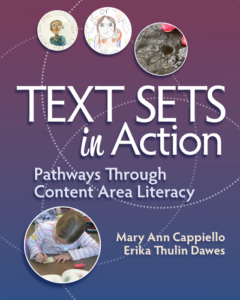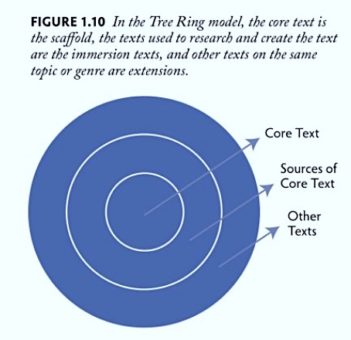Keys to Using Text Sets across Content Areas
Text Sets in Action: Pathways Through Content Literacy
By Mary Ann Cappiello and Erika Thulin Dawes
(Stenhouse Publishers, 2021 – Learn more)
Reviewed by Sarah E. Pennington
 Text Sets in Action: Pathways Through Content Literacy provides concrete guidance and examples for the teacher who wants to utilize text sets in the classroom, whether they are experienced and want to hone their use of text sets or are new to their use.
Text Sets in Action: Pathways Through Content Literacy provides concrete guidance and examples for the teacher who wants to utilize text sets in the classroom, whether they are experienced and want to hone their use of text sets or are new to their use.
The organization of the book and the resources it shares make it a valuable addition to any teacher’s professional library!
 The authors organize the book into three sections. The first section introduces text sets as a tool for supporting student learning. The authors define texts broadly, including videos, webpages, images and artifacts such as sculptures and buildings in their definitions.
The authors organize the book into three sections. The first section introduces text sets as a tool for supporting student learning. The authors define texts broadly, including videos, webpages, images and artifacts such as sculptures and buildings in their definitions.
Texts are then discussed as immersions (closely tied to the theme or topic of the text set), scaffolds (building student knowledge and interest) and extensions (texts that move beyond the curriculum standards to stretch student understanding).
Duets, sunbursts, and tree rings
Cappiello and Dawes also share multiple models for utilizing text sets, including the duet model, which offers a pair of texts that can be compared and contrasted, or in which one can serve as a scaffold for the second.
Introducing the duet model first shows the reader that text sets do not have to be overwhelming. Using just two texts is an excellent first step for teachers new to set-making.
The authors also take into consideration how mandated curriculum can impact teacher’s use of text sets by including two models (Sunburst and Tree Ring) that use a core text as the immersion or anchoring part of the set.

Seeing text sets at work
The second section of the book consists of text sets the authors have utilized in classrooms. These chapters each include :
- discussion of the goals for student learning and the standards considered in creating the text sets
- a narrative of the implementation
- a reflection on how the text set could be refined for future use,
- a reflection from one of the classroom teachers who utilized the text sets, and
- a list of the texts used in the chapter.
Each chapter is filled with images of student work, anchor charts, and other resources that give the reader a glimpse into the classroom enacting the text set.
The authors are very honest about hiccups experienced and adjustments made as these text sets were launched in the classroom. I found this valuable, as it normalizes the idea that few (if any) lessons go exactly as planned and that’s okay. We also see teachers using data from their trials to improve their focused instruction, whether it was a whole class mini-lesson on effective note taking or a small group lesson in making inferences.
Text sets for language arts, science, math and social studies
The third section of the book provides text sets for language arts, social studies, science, and mathematics (1 chapter for each) with guidance for implementing them in your own classroom. The chapters include the suggested text sets, activities for introducing them in class, student graphic organizers, and topics for discussion. These chapters are thorough enough to provide a starting point without being overly prescriptive.
Overall, Text Sets in Action is an excellent book for teachers across grade levels and subject areas. It would be especially powerful for vertical teacher teams who would like to engage in purposeful interdisciplinary learning, as it illustrates how text sets can be an excellent tool for engaging students with learning goals that cross content areas.
Dr. Sarah E. Pennington taught middle school language arts for a decade before returning to school to pursue her doctoral degree in curriculum and instruction. She is currently an assistant professor at Montana State University, where she teaches pre-service educators the ins and outs of supporting young literacy learners. She also provides professional development in literacy and motivation to teachers across the nation.

































